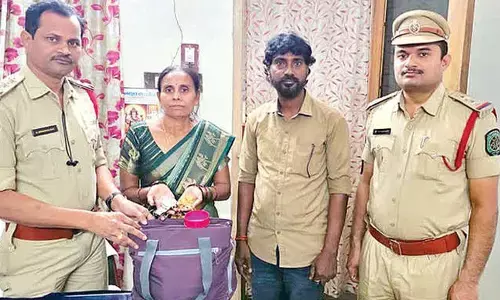Toys are more than utilitarian objects

Display figurines are passed on from one generation to another as heirloom, and are often several generations old. Also at Dasara, Diwali and Sankranti times, marriages of dolls are performed with much gaiety and toy especially by young girls. The creation of figurines, and endowing them with life, is a practice that has figured in novels, movies and also in Hindu mythology. Around the world, there are many centres known for highly developed toy making enterprises. Examples are many: Etikoppaka and Kondapalli in AP, Nirmal in Telangana, Channapatna in Ramanagara district of Karnataka, Seiffen in Germany etc
"Toys are children's words and play is their language," said Garry L Landreth.
With toys comprising an important part of human existence, the toy industry has had a substantial impact on the economies of many countries, China, Germany, Czech Republic, Hong Kong, and Vietnam being the prominent ones among them. Globally, it is a 90 billion dollar market. Major toy markets of the world are North America, Europe, Asia Pacific, because of increased spending on entertainment and play kits. India's toy exports reached the figure of US $1.35 billion in 2021 and are projected to more than double in the next few years.
Around the world, there are many centres known for highly developed toy making enterprises. Artisans in Etikoppaka, a small village on the banks of Varaha river in Andhra Pradesh state, for instance, make toys considered 'one with nature' out of natural elements such as seeds, bark, rocks, and leaves. With assistance from organisations such as the National Institute of Design, they have turned out products which have received recognition at the national and the international levels and the products have been displayed at various prestigious venues, including the Rashtrapati Bhavan. They are sold in various countries across the world, including the USA, Australia, France, Italy, and Germany.
Another town, also in Andhra Pradesh state, that has carved out a special niche for itself, in the realm of toy making, is Kondapalli in Krishna district. The artisans, known as Aryakshatriyas, find a mention in the Brahmanda Purana, and trace their origin to Muktarishi, a sage said to have been endowed with skills in arts and crafts by Lord Siva. Believed to have migrated from Rajasthan in the 16th century to the village, they continue a tradition more than four centuries old, of making parts of toys from softwood. The parts are then joined, by a paste of tamarind seed powder and sawdust, and coloured with oil or water colors, vegetable dyes or enamel paints. The toys depict figures of mythology, animals, birds, etc., with the 'Dasavataram' being the most notable one. Channapatna in Ramanagara district of Karnataka state is another noted venue for the toy industry. Products of the traditional craft practised by the artisans have gained Geographical Indication (GI) recognition under the World Trade Organisation, and are marketed in many places across the world, including the USA, European countries and countries of the Asia-Pacific region.
Traditional wooden toys made in Nirmal town, in Telangana state, are also very popular.
The Koppal Toy Cluster, being set up by the Aequs Infra company is the first such complex in India, will be operational in March 2022. It is coming up on a spread of over 400 acres of land and will comprise the entire value chain of capabilities ranging from toy making, production of packaging, tool making, paint making, developing electronics and other accessories. The cluster is also estimated to attract an investment of over Rs 4,000 crore and create over 25,000 direct jobs (mostly for women in North Karnataka) and over a lakh indirect jobs. It cluster will house over 100 large and small manufacturing units.
Seiffen, in Germany, is a true toy town where thousands of intricately carved wooden toys are created each day, including gingerbread houses and even a Baroque miner's church. The iconic Erzgebirge toy museum is also located there.
Matryoshka dolls, also known as Russian dolls, are a set of wooden dolls of decreasing size placed one inside another. The 'Teddy Bear,' named after President Theodore Roosevelt, became a popular children's toy and has been celebrated in story, song, and film. I carried one round the world for my daughter, when I went abroad with the Vice President Hidayatullah in 1981. The Newton's cradle is a device that demonstrates the conservation of momentum and the conservation of energy with swinging spheres. It is generally used as a relaxing diversion on the desk by busy executives.
Golu is a display of dolls and figurines in South India during the autumn festive season, particularly around the multiday Navaratri Dasara festival. These displays are typically thematic, narrating a legend from a Hindu text to court life, weddings, everyday scenes, and miniature kitchen utensils. They are also known as Telugu in Bommala Koluvu. Young girls and women display dolls, figurine, court life, in the Tamil, Kannada, and Telugu households.
Display figurines are passed on from one generation to another as heirloom, and are often several generations old. Also at Dasara, Diwali and Sankranti times, marriages of dolls are performed with much gaiety and toy especially by young girls.
Then there is this interesting story in Greek mythology about Pygmalion, a legendary figure of Cyprus, who was a king and a sculptor. He carves a woman out of Ivory and falls in love with the sculpture. Later on his wish for a bride who would be 'the living likeness of my ivory girl,' being granted by Aphrodite, the goddess of love and beauty, the sculpture actually turns into a woman and Pygmalion gets married to her. The attraction leading to that is a rare condition that caused that is known as Agalmatophilia.
The creation of figurines, and endowing them with life, is a practice that has figured in novels, movies and also in Hindu mythology. For example, Ganesha is the Hindu God who is invariably worshipped before an important task is undertaken. He is also the principal deity in Jainism and Buddhism. The son of Shiva and Parvati, he was created by his mother using earth moulded into the shape of a boy. Then there is the novel, 'Frankenstein,' by Mary Sheller, about a gifted scientist, Victor Frankenstein, who succeeds in giving life to a being of his own creation. The creation, however, turns out not to be the perfect specimen he intended, but a hideous creature, seeking revenge through murder and terror. In the popular Telugu movie of yore, 'Punarjanma,' Gopi, a sculptor, goes mad when an electrical short circuit destroys his sculpture. His doctor then uses the services of a dancer and singer to restore sanity to Gopi.
Somewhat larger, than the toys that the children normally play with, though it may have been, the 'Trojan horse' was, in a manner of speaking, also a toy. The wooden statue helped conceal Greek soldiers to enable their entry into the city of Troy, in order to overrun, and take, the city, after a fruitless ten year siege. That is the reason why one is advised to "beware of a Greek bearing a gift," as the Trojan priest Lacoön said in Virgil's epic poem Aeneid. The term 'Trojan horse' has also come to mean, in the computer in world, a program apparently performing an innocuous function, but designed to breach the security of the computer.
So universal is the belief that dolls are good looking that a young and attractive woman is often referred to as a 'baby doll.' The expression is also sometimes used in slang to describe a woman who is dull and expressionless but otherwise good looking.
(The writer is formerly Chief Secretary, Government of Andhra Pradesh)

















